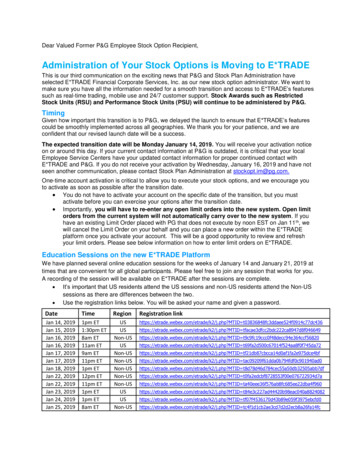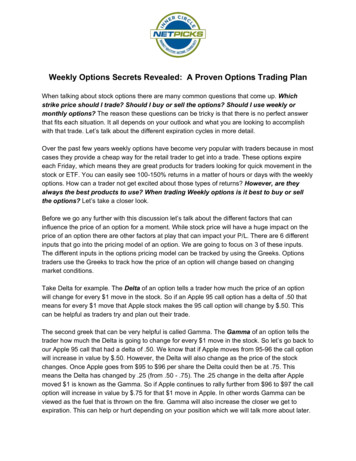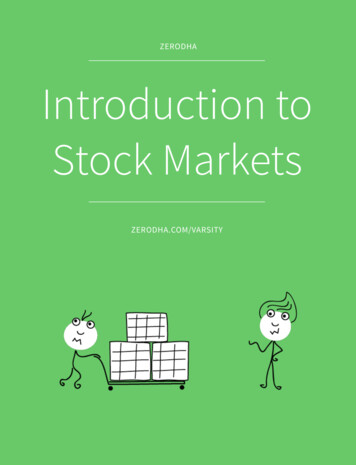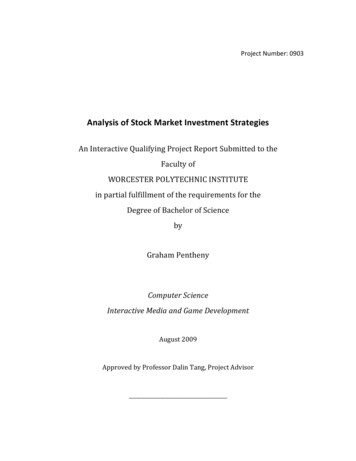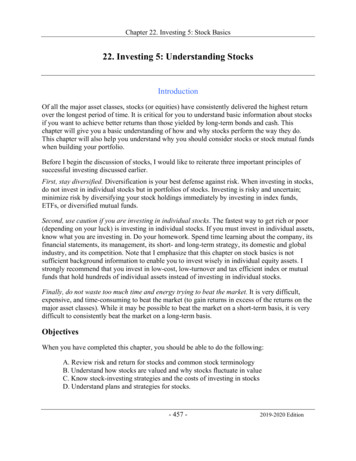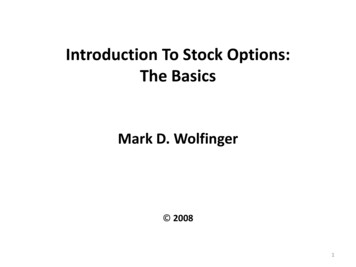
Transcription
Introduction To Stock Options:The BasicsMark D. Wolfinger 20081
Table of ContentsIntroductionChapter 1. What is an Option?Chapter 2. How Does an Option Work?Chapter 3. Stock OptionsChapter 4. Getting StartedChapter 5. Option BooksChapter 6. TradingChapter 7. Option StrategiesChapter 8. ConclusionGlossaryRead my blog, written for rookies: http://blog.mdwoptions.com/options for rookies/2
This is a free eBook. You may distribute it to anyone.Additional copies are available: http://www.mdwoptions.com/TheBasics.pdfDisclaimer: The information presented in this eBook is for educational purposes only. I neither make nor suggest anyspecific recommendations for investment. Examples are for illustrative purposes only, and serve to show what mayhappen in a specific situation. Conservative investment strategies improve your chances of earning a profit, but lossescan still occur.3
IntroductionThis eBook is intended to give you a taste of the world of stock options. There’s enoughinformation for you to decide if you truly want to learn more. If the answer is “yes” links toadditional information are provided.The language of options is introduced, but words that are new to you are kept to aminimum. These new words are in bold the first time they appear. For those interested inlearning additional option terminology, a larger glossary is available here.Your study of this subject can be as simple or complex as you desire. The purpose of thisbooklet is to provide the most basic introduction, and everything is at an introductory level.Let’s get started.4
Chapter 1What is An Option?An option is an agreement, or a contract, between 2 people: The buyer and the seller.The price paid for the option is the premium.There are 2 types of options: calls and puts.A call is the right to buy (and a put is the right to sell): A specific item (the underlying asset). At a specific price (the strike price). For a specific time (until expiration).That is all there is to an option. It’s not complicated.5
If you ever received a rain check at a supermarket, then you’ve used a call option. The raincheck gives you the right to return to the store to buy a certain item at a sale price. The raincheck is good for a short period of time.The premium is zero, because you received the rain check for free. The underlying is theitem on sale. The strike price is the sale price. The expiration is the last day the rain check isvalid.Rain checks are very simple items. Stock options are no more complicated than that.6
Chapter 2How Does An Option Work?An option owner has rights. An option seller has obligations.A call owner has the right to buy the underlying by paying the strike price. But, he/she doesnot have to do so. There is no obligation. If the option owner chooses to do what thecontract allows, then he or she is said to exercise the option.An option seller has no control over when, or if, the option owner exercises the option. Ifthe owner does exercise, then the seller is assigned an exercise notice and is obligated tohonor the conditions of the contract: The call seller sells 100 shares of stock and receives the strike price per share The put seller buys 100 shares of stock and pays the strike price per shareHow does an option work in our everyday lives? When you return to the supermarket touse the rain check, you are exercising your call option. When you hand it to the cashier,that is the store owner's notification that he/she has been assigned an exercise notice andmust sell the underlying at the strike price.7
Chapter 3Buying Selling, Exercising OptionsWhen you use options in the stock market, the underlying asset is 100 shares of stock.When you enter an order to buy or sell options, your broker sends it to one of the optionsexchanges where the order is executed. This is the same method used to buy or sell sharesof stock.If you ever elect to exercise an option, notify your broker, who takes care of the rest of theprocess for you.If you sell an option and later are assigned an exercise notice, it’s your broker who notifiesyou (before the markets open for business the following morning).8
Chapter 4Getting StartedYou must have a brokerage account before you can trade options. If you don’t already haveone, several good brokers are available.Because trading options is not for everyone, it’s a good idea to read an educationalpamphlet before you begin trading: Characteristics and Risks of Standardized Options.Your broker will send a copy, but it’s also available /risks/riskchap1.jspYou must open a margin account. Don’t let this concern you, because it’s a requirement foroptions trading. A margin account allows you to borrow money from your broker, but youdon’t have to do so.9
Chapter 5Option BooksIf you want to learn more about options, there are many books on the subject. Visit yourlocal library, bookstore, or browse Amazon.com.I’ve written three books specifically for the options beginner, the most recent is TheRookie’s Guide to Options.10
Chapter 6TradingWhen trading options, you require a source of option quotes and your broker shouldprovide them. If that doesn’t work for you, get quotes from one of the options exchanges.CBOE: ir value of optionsAn option can be described in mathematical terms and it’s possible to calculate atheoretical, or fair, value for an option. Fortunately it’s unnecessary to get involved withthe math because calculators are available to do the work.One such calculator can be found at my web mlOr use one provided by the CBOE (Chicago Board Options lculator.aspx11
To use the calculator, you must have some idea of the inputs used in the calculation. Theyare: Stock Price ·Strike Price Volatility Interest Rate Dividend Days remaining before expirationThe only one of these terms that should be new to you is ‘volatility.’ In simple termsvolatility is a measure of the tendency of a stock to experience price change. Stocks thathave frequent, large price changes are volatile and their options trade at much higherprices than options of stocks that don’t move much.Volatility is very important to options traders and a more thorough discussion is availablehere.12
Chapter 7Option StrategiesOptions are versatile and there are many ways to use them. Some are highly speculative.Some are conservative. I recommended that you learn conservative strategies when youbegin trading options. Later, if you must, you can attempt other methods.I believe that conservative strategies are so beneficial in helping you earn additional profitsfrom your investment portfolio, that I not only highly recommend them, but stress them inmy books.You can find detailed instruction on how to adopt, and manage, my favorite strategies inThe Rookie’s Guide to Options. Or you can visit my blog and get started with shortdiscussions on various strategies. In the right-hand column, click on the strategy you wantto read about.13
Chapter 8ConclusionThe material presented in this eBook is meant to be an introduction to the optionsuniverse. If this is your first time you have encountered options, you have much to learnbefore being ready to use real money to buy or sell options.Continue to read and learn. Ask your broker to open a paper trading (practice) account inwhich you can gain option trading experience, using play money.More information is available: Library Bookstore Ask your broker http://www.mdwoptions.com http://blog.mdwoptions.com/options for rookies/Good trading!This information was provided with the sincere hope you become interested in learningmore about using options wisely.14
GlossaryPremium – The price of an optionCall – An option contract giving its owner the right to buy the underlying asset at the strikeprice for a specified period of timePut - An option contract giving its owner the right to sell the underlying at the strike pricefor a specified period of timeUnderlying – The item the call owner may buy and the put owner may sellStrike Price – The price at which the option owner may buy or sell the underlyingExpiration – The day, after which an option is no longer a valid contractRights – Attributes given to the option ownerObligations – Attributes accepted by the option sellerExercise – The process by which an option owner does what the contract allowsAssigned – Notification that the option owner has exercised rights and you are nowrequired to fulfill the conditions of the contract15
About the AuthorI began trading options for my own account in 1975 and two years later became an optionsprofessional as a market maker on the trading floor of the Chicago Board Options Exchange(CBOE). Since mid-2000, I’ve been teaching individual investors how to adopt riskreducing, profit-enhancing option strategies.I’ve published three books and many magazine articles .My latest book was released in February, 2008. The Rookies Guide to Options: TheBeginner's Handbook of Trading Equity Options provides a thorough introduction tooptions, helping readers understand how options are used to make money and reduce risk.The book allows the reader to follow along as a seasoned trader makes trading decisions.Six option strategies are described in detail.If you always wanted to learn about options, this is the book for you.More information is available: book (at) mdwoptions (dot) com.16
Beginner's Handbook of Trading Equity Options provides a thorough introduction to options, helping readers understand how options are used to make money and reduce risk. The book allows the reader to follow along as a seasoned trader makes trading decisions. Six option strategies are described in detail.

